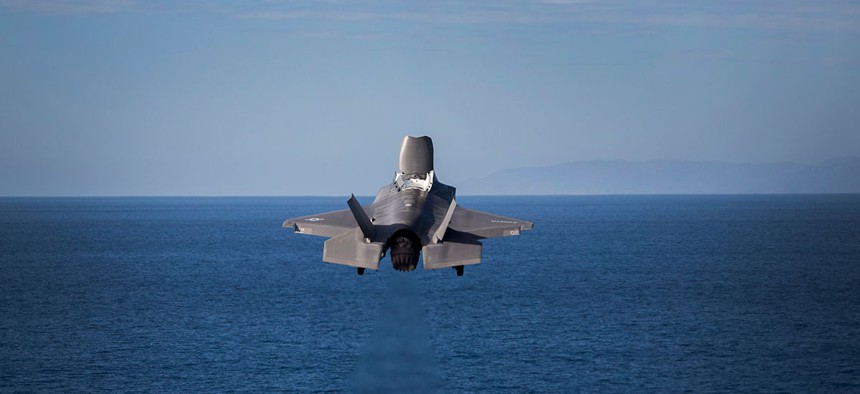
Lance Cpl. Dana Beesley/United States Marine Corps
The F-35B Just Got A Lot Deadlier
In a proof-of-concept experiment, data passed instantly from a Marine Corps fighter allowed a shipboard Aegis system to shoot down a drone.
The F-35 now packs more punch: specifically, the 20-foot Standard Missile, or SM-6, complete with a 140-pound warhead. But not fired from under the wing — rather from a nearby Aegis destroyer.
In September, the Marines completed a proof-of-concept test in which a Marine Corps F-35B detected a cruise-missile decoy (a drone), passed targeting information to a remote sensor, and set up a shot by an Aegis combat system of the sort you’ll find on modern destroyers. A battery controlled by the Aegis fired a live SM-6 missile, which took down the drone.
“It was a metal-on-metal engagement from a significant range. I would say more than a tactically significant range. It was a very, very impressive shot to see,” Lt. Col. Richard “BC” Rusnok told reporters aboard the amphibious assault ship America, where the Marines are conducting tests with the vertical-lift F-35B. The test took place at White Sands, New Mexico, aboard the USS Desert Ship facility that the Navy uses for missile tests there.
The process of selecting the target and then launching a missile to take it out was virtually automatic, said Rusnok.
“It’s super simple,” he said. “It’s targeting the way we target our own ship weapons [aboard the F-35]. There’s really no difference. It becomes a battle management issue as to who is going to engage, but the physical pushing of data is transparent to the pilot because the picture is a common picture.”
That pushing takes place over the Ku-band multi-function advanced datalink, or MADL: basically, the same encrypted datalink that stealth aircraft use to speak to one another while maintaining apparent radio silence.
The test shows that the F-35 has effectively become a lot more dangerous (so long as the datalinks are working.) Imagine you’re a radar operator in a country that has just declared war on the United States. Your country has been moving missiles and radars around on the ground, hoping to dodge American satellite cameras before you can get your shots off. You hear a whoosh overhead, a squadron of F-35s electronically surveying the landscape for appropriate targets to take out, and behind them, huge SM-6 missiles are flying at supersonic speeds to hit those targets. The F-35 has become a sort of fighter bomber hybrid.
“Aegis cruisers bring a weapons payload that you just couldn’t fit on an airplane. We’re talking about dozens and dozens of Standard Missiles, SM-6s, that can be targeted by airborne platforms at a much longer distance,” said Col. George “Sack” Rowell.
“Nothing else can do that,” said Lt. Gen. Jon Davis, the Marines’ deputy commandant for aviation.
Davis said the Marines are on track to deploy the F-35B to Marine Corps Air Station on Iwakuni, Japan, in January. Japan’s air self-defense forces are also going to acquire 42 F-35s.
The Aegis Ballistic Missile Defense system is present on 33 ships, 16 of which are deployed to the Pacific.
NEXT STORY: America’s War-by-Airstrike in Three Charts







